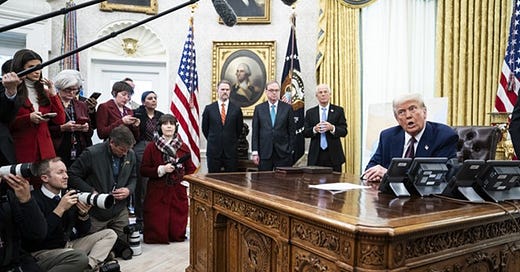Mainstream Media's Stranglehold is Broken: The AP’s Exclusion as a Turning Point
The AP’s exclusion from key White House events marks a shift in media power, breaking the mainstream media’s unchecked influence. This paves the way for diverse voices and a more balanced narrative.
The AP Ban: A Wake-Up Call for Media Accountability
For years, the mainstream media in the U.S. has enjoyed unparalleled influence, shaping the narratives of political events, policies, and figures. But that dominance is now being challenged, especially with the Trump administration’s recent decision to bar the Associated Press (AP) from certain key White House events. This decision, while largely symbolic, marks a significant step in breaking the stranglehold the mainstream media has had on the political narrative. The exclusion of AP from the Oval Office and Air Force One is not just about access; it is a clear response to the blatant bias many outlets, like the AP, have shown over the years, particularly in their coverage of President Donald Trump.
The White House’s stated reason for the exclusion was that the AP "weaponizes language" through its editorial choices. The decision follows a broader trend of media bias that has been evident in how certain outlets, like the AP, have consistently supported specific political agendas—particularly those aligned with the Democratic Party. It’s no secret that USAID, a government-funded agency, has become a source of financial support for media outlets that align with progressive and left-leaning political views. This has been the subject of multiple audits, including one recently conducted by DOGE, which found clear evidence of taxpayer funds being funneled in ways that promoted certain political ideologies and media bias.
The DOGE audit exposed how these taxpayer dollars, intended for development and international aid, were used to bolster media organizations that effectively acted as a mouthpiece for the Democratic party. The AP, along with other outlets, has long been a part of this dynamic. These revelations are not just about government oversight; they speak to a deeper issue of media influence and its role in shaping public opinion to benefit a specific political agenda.
The media’s bias against Trump is not a coincidence. Editors, reporters, and writers are overwhelmingly aligned with the Democratic Party, and many have shown a visceral dislike for the man. Whether intentional or not, this bias has been reflected in their reporting, distorting facts and shaping narratives that have worked against Trump. The mainstream media became an extension of the Democratic Party, shaping the narrative to serve their political interests, rather than reporting the news in an unbiased, factual manner. This coordinated effort, whether explicit or implicit, has undoubtedly played a significant role in shaping public perception.
For years, media outlets like the AP enjoyed unfettered access to the White House and Air Force One, and they used that access to shape public discourse, often in a manner that was dismissive of or even hostile toward the Trump administration. The White House’s decision to cut off access is a reflection of a shift in the balance of power, as Trump makes room for other voices to have a say, voices that have historically been excluded from the narrative controlled by the so-called mainstream media.
In this context, the AP’s exclusion is a necessary response to the media's failure to serve the public impartially. It is not just a consequence of the AP's biased reporting; it is a wake-up call for the media at large. When the media operates as a political arm of one party, it ceases to fulfill its essential role in a free society. The AP and other outlets have abused their position as journalists, crossing the line into activism. This is not what the media is meant to do. It is meant to inform the public, not manipulate them.
The AP’s exclusion from key White House events marks a significant turning point in the breakup of mainstream media's unchecked and once dominant influence, as Trump makes room for diverse media voices. This shift is essential for restoring balance and ensuring that the media serves the public rather than the political agendas of their preferred party.




